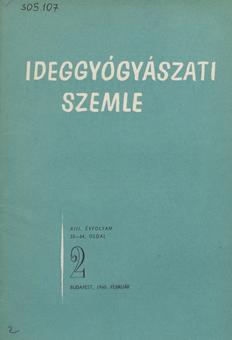The eLitMed.hu medical portal uses computer cookies for convenient operation. Detailed information can be found in the Cookie-policy.
Clinical Neuroscience - 1960;13(02)
Content
[Atypical epileptic psychoses]
[We reported on 8 patients, five with depressive symptomatology, two with paranoid schizophreniform psychosis, one with abnormal drunkenness, and all with characteristic epileptic paroxysms on EEG. Two of our patients had a previous history of motor seizures 17 and 6 years ago, and one patient had epileptic character changes. The psychoses were clinically very different from those of typhoid epileptic psychosis, with similar course and response to anticonvulsant drugs. Without being able to draw conclusions on localization, the EEG was one of the expressions of organicity, other data also suggested that the presence of an organic background was evident and that this would give the direction of therapy.]
[Observations on paralysis spinalis spastica in a family]
[Authors observed paralysis spinalis spastica in three members of a family belonging to two generations. The onset in all three cases was adult onset. Their cases are consistent with the literature and are considered to be typical. After raising clinical differential diagnostic issues, the scarce national publications on the observation of heredo famililiaris neuropathies are highlighted.]
[Foramen Magendie obstruction and surgical treatment]
[1. Occlusion of the FM may result from a developmental abnormality or an inflammatory process. 2. F. M. obstruction is clinically manifested by occlusive hydrocephalus and surgical intervention is aimed at removing the occlusion. 3. In cases of F.M. occlusion of inflammatory origin, given the early recurrences known from the literature and our experience, we always recommend surgery consisting of resection of the lower part of the vermis and the tonsils or medial part of the cerebellum. In our experience, this resection surgery can prevent recurrences caused by postoperative sterile inflammation.]
[Control of caloric nystagmus by medication]
[Among the chlorpromazines, Hibernal and Largactil reduce the nystagmus induced by the caloric stimulus at lower doses and prevent it at higher doses. In two cases of central spontaneous nystagmus of unknown origin, IV Largactil abolished both spontaneous and caloric nystagmus. One of these was also given Evipan. Evipan did not reduce calorias nystagmus. The significance of these experiments is as follows : We consider that the anti-dizziness effect of chlorpromazine through its action on the central vestibular apparatus has been proven. By testing drugs acting on the central vestibular apparatus, we can obtain a new pharmacological diagnostic procedure.]
[Hemiconvulsive treatment]
[Based on literature and our own experience, we described the methodology, results and benefits of hemiconvulsive treatment. We are not yet in a position to statistically evaluate the therapeutic effect of the treatment. ]
1.
Clinical Neuroscience
[Headache registry in Szeged: Experiences regarding to migraine patients]2.
Clinical Neuroscience
[The new target population of stroke awareness campaign: Kindergarten students ]3.
Clinical Neuroscience
Is there any difference in mortality rates of atrial fibrillation detected before or after ischemic stroke?4.
Clinical Neuroscience
Factors influencing the level of stigma in Parkinson’s disease in western Turkey5.
Clinical Neuroscience
[The effects of demographic and clinical factors on the severity of poststroke aphasia]1.
2.
3.
4.
5.



